

Editor’s note: This survey was created and conducted by EquiManagement and Amy Grice, VMD, MBA, in order to gain insights on equine practice, changes, issues and outlooks from the 2020 COVID-19 pandemic. This article is brought to you by Merck Animal Health. This article was written in October of 2020 following the survey administration in August of 2020, but the numbers in the initial paragraph below were updated to reflect the state of the world at the time of the initial posting. This article won the American Horse Publication’s top award for “Breaking News or Investigative Reporting Single Article.”
As of December 24, 2020, more than 77.5 million cases of COVID-19 had been reported in more than 200 countries and territories, resulting in more than 1.7 million deaths. In the United States, 18.5 million cases with at least 326,000 deaths had been reported, according to the World Health Organization (WHO).
As the virus spread across the U.S. in March of 2020, states issued orders to close non-essential businesses and limit group activities. The U.S. stock market plummeted to below 20,000 in mid-March. On the week ending March 21, 3.3 million new unemployment claims were made, followed by an additional 6.6 million the week ending March 28. At its peak, unemployment rose to more than 14%.
In order to evaluate the effect of these events on equine practices, a 21-question survey was distributed on the closed Facebook groups Women in Equine Practice, Equine Vet-2-Vet, AAEP New Practitioner and AAEP Member Vet Talk. A link also was posted on the AAEP General Communities e-mail Listserv. The survey was open August 9–25, and 207 veterinarians responded.
Demographics
In order to learn some demographic information about the respondents, questions included the year of graduation from veterinary school, whether the respondent was an associate or an owner, and the gender of the respondent. All of the questions allowed the veterinarians to write comments, and they wrote many to explain their answers.

Almost 12% graduated in the last five years, and about 20% finished veterinary school six to 10 years ago. About 24% of respondents graduated 11 to 15 years ago, around 8% graduated 16 to 20 years ago, and about 35% of respondents graduated more than 20 years ago.
Three-quarters of respondents (75%) indicated that they are practice owners, and about a quarter (25%) said they are associates. About 75% of respondents were female, and 25% were male. Respondents were asked for the geo graphic zone in which they practiced, and results indicated a very uniform participation across regions.
Pandemic Operations
Respondents were asked “In general, how has the pandemic affected your practice’s operations?” 6.3% of respondents said “Greatly—A great deal”; 23.2% responded “Moderately—Quite a lot”; 57.5% responded “Mildly—A little” and 13% responded “Not at all” (see Figure 1).
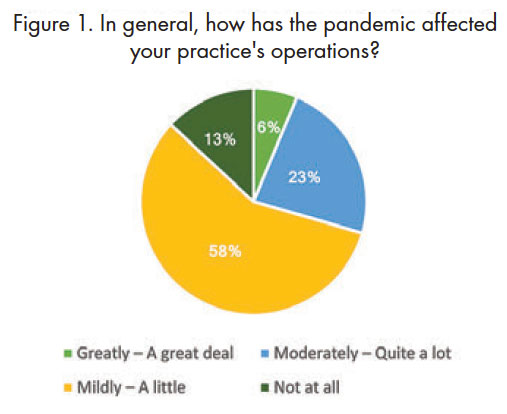
When looking at this question by zip code zones (the zone number corresponds to the first number of each region’s zip code), there was quite a bit of variation (see Figure 2). This was likely due to variability in the severity of the COVID-19 outbreak in each area and the differing state governmental responses to the pandemic. Zones 5, 7 and 9 had the highest percentage of responses that the pandemic had affected operations “Greatly—A great deal,” with 13.3%, 11.1% and 9.1% respectively.
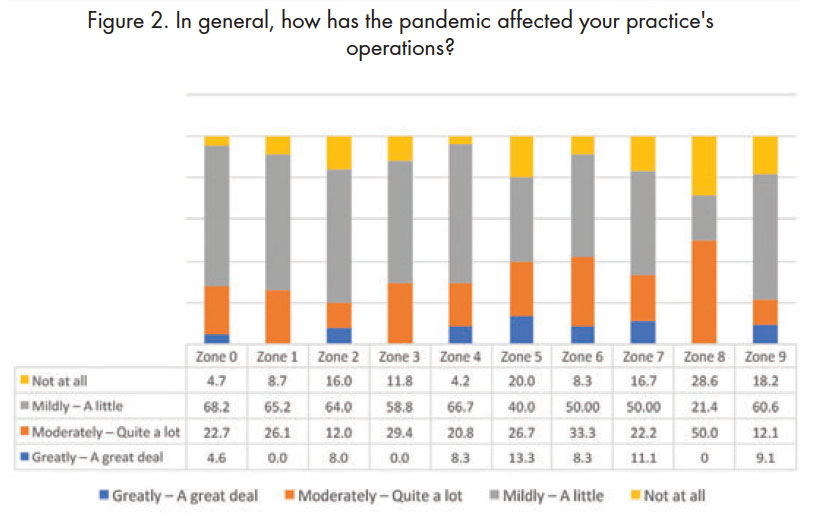
When looking additively, Zone 5 (40%), Zone 6 (46%), Zone 7 (33.3%) and Zone 8 (50%) had the highest percentage of “Greatly—A great deal” and “Moderately—Quite a lot.”
Financial Impact
Financial performance of companion animal practices in the U.S. was tracked weekly beginning in March by VetSuccess with its Veterinary Industry Impact Tracker. While there were some initial revenue drops, these practices came roaring back with revenues that—as of September—had increased year over year by an average of 11.3% nationally. The survey of equine practices reported in this article sought to qualitatively measure the financial performance of equine practices by asking “Has the pandemic negatively affected your practice’s finances?”
When looking at all respondents, 29.5% said “No, my practice is financially about the same as before COVID-19” and 27.5% said “No, my practice is financially better than before COVID-19.” Only 2.9% said “Yes, greatly—A great deal worse.”
However, not unexpectedly, there were variations when responses were separated by zip code zone (see Figure 3). Practices in Zone 4 (8.3%), Zone 5 (6.7%) and Zone 7 (5.6%) reported the highest percentages of the response “Yes, greatly—A great deal worse.”
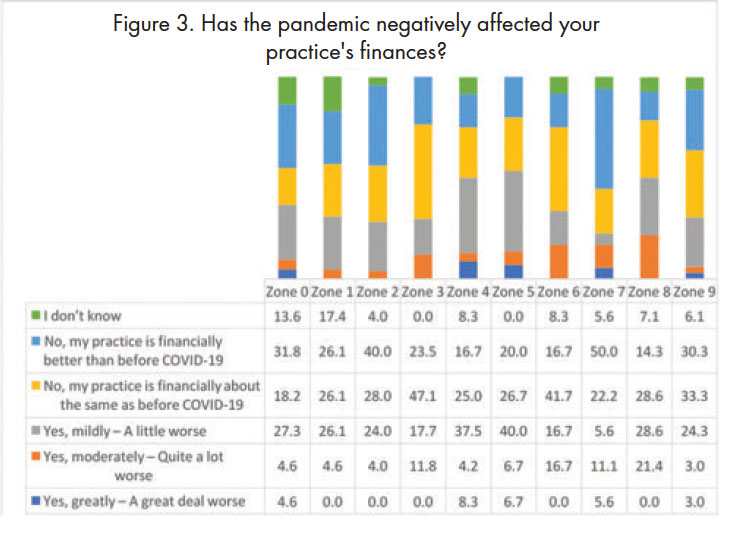
Interestingly, 50% of Zone 7 respondents reported “No, my practice is financially better than before COVID-19,” the highest percentage among the zones of this response. Other zones with many responses of higher financial performance included Zone 0 (31.8%), Zone 2 (40%) and Zone 9 (30.3%).
Operational Changes
The survey also asked about changes in operations caused by the pandemic or by state mandates put in place to manage COVID-19.
About 29% of respondents had no changes in their offered services, while another 30% had at least some period of time where they only saw urgent or emergency cases. Almost three-quarters of respondents reported using personal protective equipment while working, and almost a quarter increased their use of telemedicine or began to use it for the first time.
About 20% reported that they reduced hours, laid off or furloughed non-DVM staff, but only 7.7% reported that they reduced hours, laid off or furloughed veterinarians. 14% said they split practice members into teams working different days.
When asked “In which areas is your practice “back to normal” now?”, 53.9% of respondents indicated that all areas were operating normally.
Impact on Industry
The equine industry in some areas was subject to specific state mandates that strictly limited activities of horse owners at boarding stables, racetracks and competition venues. Respondents were asked “In general, how has the pandemic affected the equine industry activity in your region (breeding, showing, training, boarding, racing)?” Most respondents indicated that their areas had a mild to moderate decrease in activity. Responses differed somewhat by zip code zone. Those zones that saw the highest effect on the equine industry, answering “Greatly—A great deal,” were Zone 0 (18.2%), Zone 4 (16.7%) and Zone 9 (15.6%). When looking additively at responses of “Moderately—Quite a lot” and “Greatly—A great deal,” Zone 3 was most affected at 70.9%, followed by Zone 3 at 70.6%, Zone 7 at 66.7% and Zone 5 at 66.6%.
Changes in Practice
Practices were uncertain about the economic effects that would endure as a result of the pandemic. The survey asked about the utilization of federal aid. 56.1% of respondents said their practices utilized a federal program for financial assistance (PPP, SBA loan, etc.).
Survey respondents were asked “What changes in your operation or in the industry do you think will be permanent, or maintained as the new normal?” While a number of veterinarians indicated they thought telemedicine and online pharmacies would be used more frequently, many said they hoped that “we can just return to normal,” with no permanent changes. Others felt that social distancing, increased sanitizing and continuing curbside service might become permanent changes.
Thrive or Survive
When asked “What is the most important thing that you or your practice did or is doing to thrive or survive in 2020?”, respondents had many different responses:
• “Continue to foster a supportive working environment that provides everyone with time they need to take care of themselves/their families.”
• “Going back to our brand and our message. Making sure that each interaction with clients is a true reflection of what we represent.”
• “Posted that we were working and available to clients. But we stressed mask wearing, hand washing, social distance and disinfection.”
Many answers spoke about being available and stressing good communication with staff and clients.
Biggest Concerns
Our COVID-19 survey of veterinarians in the spring of 2020 asked respondents to rank their concerns, the current survey queried “Which concerns you the most?” The ranking of these concerns in the current survey was the same in the spring survey.
Respondents indicated that they were most concerned about their family member(s) getting ill, followed by getting sick themselves. Third-ranked was the effect of the economic downturn on the household’s or personal finances.
Ranked less important in the recent survey were “Your community and the world being sickened and people dying with COVID-19,” “the effect of the economic downturn on your practice or the practice where you work,” “the effect of the economic downturn on your community,” “the effect of the economic downturn on the country and the world” and “the effect of the economic downturn on your continued employment or that of your spouse.”
Stress
Respondents were asked about symptoms of stress that they were experiencing. While 14.2% reported no symptoms of stress, almost two-thirds of respondents (62.9%) reported “feeling anxious or worried,” more than half (56.6%) reported “feeling exhausted” and about half (51.2%) were “feeling overwhelmed.” Insomnia was affecting about a third (31.2%), 38.1% reported “feeling sad or depressed” and 43.9% said they were “short-tempered and irritable.”
About a quarter were “drinking more alcohol than usual,” “overeating or failing to eat,” and “over-focusing on news stories about COVID-19” (see Figure 4). It is not clear how many of these signs of stress are a product of the pandemic and which were simply the result of the day- to-day work of equine practice. What is clear, however, is that equine practitioners are experiencing a lot of stress.
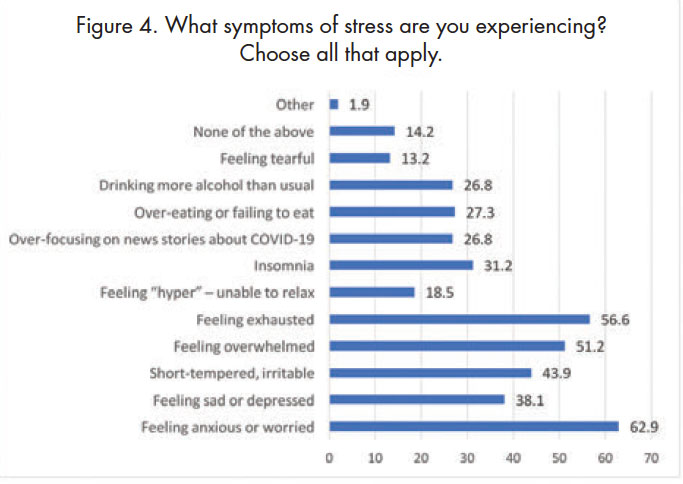
Multiple comments also spoke of the difficulties of school disruptions with distance learning requiring parental attention, and the challenges of childcare arrangements. The added responsibilities for parents on top of the time-consuming changes to many practices’ work schedules seemed to create an almost unbearable burden for many.
When comparing those respondents in practice more than 20 years with those in their first five years, there were differences (see Figure 5).
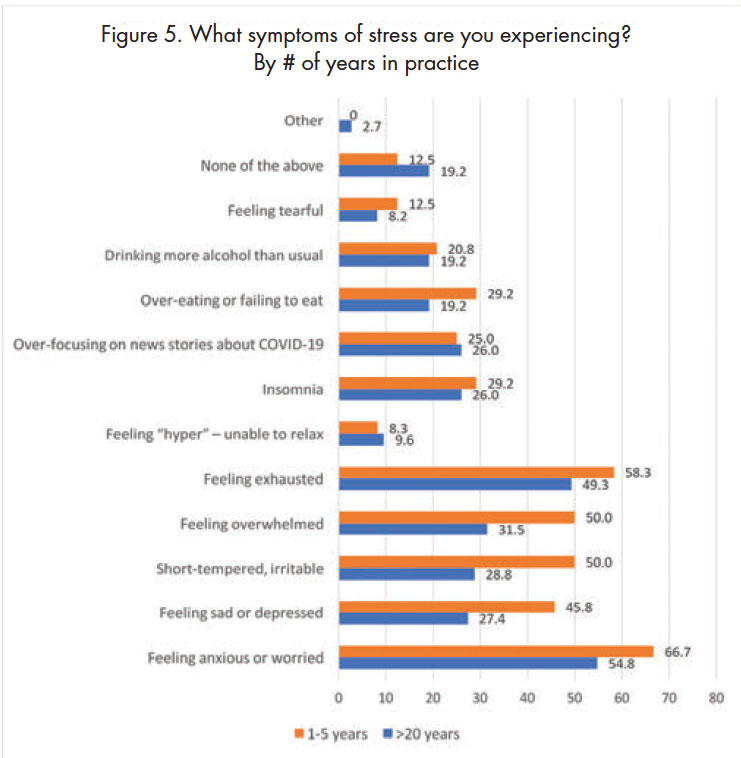
Almost a fifth of those with more than 20 years of practice were experiencing no signs of stress, compared to a little over a tenth of those early in their careers. Half of those respondents in their first five years reported “feeling overwhelmed” and “short-tempered and irritable,” compared to less than a third of the more experienced veterinarians. 58.3% of the younger cohort said they were “feeling exhausted” compared to 49.3% of the older group.
Almost half of those in their first one to five years were “feeling sad or depressed” versus only about a quarter of those with over 20 years in service. Likewise, 66.7% of the younger group reported “feeling anxious or worried” compared to 54.8% of the older.
Recognizing these increased stresses on new practitioners is important for employers as they navigate managing a busy equine practice. With retention of equine veterinarians already a concern, pressures exacerbated by the pandemic might play a role in continuing this trend.
CE Requirements
Pivoting to practical issues, the survey asked respondents how they were planning to fulfill their CE requirements in 2020. 70% planned to attend virtual continuing education events, 23% were planning to attend a mixture of live and virtual events, 3% indicated they would attend only live meetings and 4.4% said they would be unable to meet their CE requirements in 2020.
Although 79% said they would like to see more online CE because it was very useful during the pandemic, only 6.3% indicated it was their preference at all times. 14.6% responded that they do not like online CE programs. As one veterinarian commented, “I MUCH prefer one-on-one, face-to-face interactions— hugs from old friends, handshakes with new friends. I focus so much better in a room full of people than online, which just doesn’t ‘feel right’ to me.”
Industry Support
Respondents were asked “What are manufacturers, distributors and other industry partners doing—or what could they do—to help veterinarians most effectively at this time?” Many veterinarians answered that they were grateful for online continuing education opportunities, good ongoing communication with their sales representatives despite the challenges of the pandemic, and assistance working through back orders and other supply chain issues.
Take-Home Message
As equine veterinarians continue to work hard to meet the needs of their clients and patients in this difficult time, it is good to know that most are doing well financially despite their increased stress. Finding new, efficient ways to deliver care and communicate with all stakeholders could help ease some of the heavy workload.
Utilization of technicians and office staff for tasks that do not require a veterinarian’s attention could ease the strain and often are economically sensible, as well. As time goes on, life will return to a more normal rhythm, and the difficulties of this time will become a distant memory. Let us all hope that time comes soon!
We appreciate Merck Animal Health in stepping up to provide sponsorship to conduct and publish this survey and the results.








